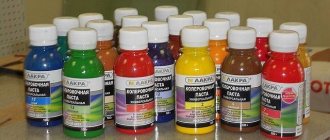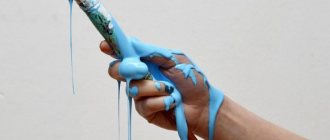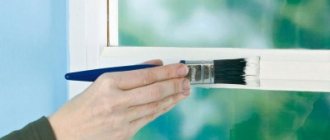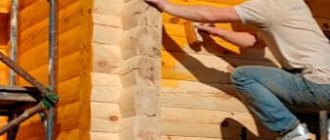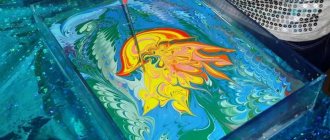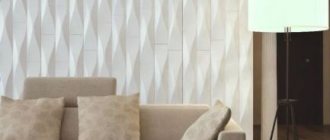There is a wide variety of façade paint on the market. Domestic and foreign manufacturers present facade coloring substances for different surfaces, different textures and colors.
Some coloring materials are made specifically for color. Coloring must be done in order to achieve the required shade of the coloring composition , which has the necessary quality characteristics.
You can add one color, or you can combine several pigment components at once to obtain a complex and unique shade.
How to choose?
Let's consider how best to choose the appropriate color scheme and what you need to focus on. Selection criteria taking into account characteristics:
- Manufacturer. Despite prejudices, a domestic manufacturer can offer a product that is no different in quality from a foreign one. And its price will be significantly lower. If the base paint has already been purchased, then it is advisable to take the color from the same company.
- Tara. It is more convenient to use packaging with a narrow neck, this makes it much easier to pour the required volume.
- Type of base paint. The most popular option is for water-based emulsion. This doesn't mean there aren't options for other foundations. But finding them on the market will not be easy.
- Availability of shade map. Almost every manufacturer has such brochures; it is much easier to select the desired shade from them. It is better to check with the seller when purchasing whether such a card is available.
- Hue. Depending on the lighting, the finished shade may look different in different rooms. The recommendation is not to mix the entire volume of the base at once, give it time to “get used to” the shade and make possible adjustments.
- Pigment type. They are organic and synthetic. For a well-lit room, it is better to choose a product with a synthetic pigment, as it is less susceptible to fading in the sun. Under artificial lighting, organic pigment looks better: it is more saturated and has natural, “pure” colors.
Polyurethane mold for 300 (customer)
Hello everyone, dear pikabushniks! Thank you all very much for the warm welcome with my first post: https://pikabu.ru/story/forma_iz_poliuretana_svoimi_rukami_d.
Honestly, I didn’t expect that this topic would be so interesting to you, more than 900 pluses and 1200+ post saves! Thank you!
Now I’ll tell you a short story and show how I did it all.
After the post, pikabushniks and pikabushnitsy started writing to me on VK, asking about all sorts of different things, what kind of gypsum is best to sculpt bricks from, where you can buy polyurethane so cheaply, and also about a dozen orders for molds were received. I am of course very pleased with everything that is happening.
One late evening a guy wrote to me about ordering a uniform, but he said I don’t need such a big one, I only need to make 2-3 m2 (an apron for the kitchen) and perhaps he says you have something suitable for me, 300 rubles?
Surface preparation
Before painting, it is important to clean the wall from dirt, traces of the previous coating, mold, etc. If the surface is uneven, it is better to plaster and sand it
It is also important that the wall covering to be painted is also white, because a dark background will be noticeable even through several layers of paint
It is also important that the wall covering to be painted is also white, because a dark background will be noticeable even through several layers of paint
If the surface is uneven, it is better to plaster and sand it
It is also important that the wall covering to be painted is also white, because a dark background will be noticeable even through several layers of paint
For better adhesion (adhesion) of the dye to the surface, it is recommended to use a primer suitable for this type of paint.
Advice. You should carefully read the instructions, recommendations for use and proportions of components indicated on the packaging.
This will allow you to avoid unpleasant surprises in the process of tinting wall paint and painting and get the desired shade without much difficulty.
And the video instructions will explain in detail how to tint the paint without mistakes.
There are several, the most popular methods of finishing wall surfaces (wallpapering, ceramic tiles, painting), each of which has a lot of advantages and disadvantages. As for painting, today it is the easiest and most inexpensive way to transform a room and make all your design dreams come true.
Most paints have excellent physical, technical and performance characteristics, and tinting the paint will help you choose the right shade
When planning to use paint in the interior of your home, you need to pay special attention to the color scheme, since the color of the walls should be harmoniously combined with all decorative elements and furniture
If the desired shade of paint cannot be purchased in a store, you can tint the paint yourself, at home.
Tinting paints at home is a responsible and difficult task, but sometimes this is the only way to get the desired shade. For example, if a person needs yellow, he can easily buy it in a store, but if the color of orange juice suits the interior (this complex color consists of yellow and orange), then it is better to tint the paint to this color yourself.
Tinting is also necessary if you need to paint a room in several colors, since only with this method will it be possible to obtain shades that most closely match each other.
Mixing paints will help you get the desired color, but here you need to know exactly which groups of paints and varnishes can be mixed with each other (some types of paints are incompatible with each other).
You also need to know exactly what shade will be obtained as a result of mixing the original paints. Recently, phosphor paint and reflective paint have been used to create a unique interior. These paints can be applied to various finishing materials.
The store can create the desired shade for the buyer in a tinting machine, but it often happens that the store sample of the house begins to look completely different.
The point here is that color is influenced by many factors (lighting, area to be painted, etc.). The advantage of home tinting is that the desired shade can be obtained immediately before painting and the color can be more accurately selected.
There are only two most important tinting rules:
1) The desired shade must be selected according to the lighting that will be in the room.
This means that you need to see how the created shade looks in different lighting: in daylight, with the electric light on.
That is, if there is a chandelier hanging in the room, then you need to tint the paint and paint the walls in the light of this chandelier, and not in another light source.
2) Applied over a large area (especially a vertical surface), the color will appear richer than on the sample.
In order for the room to be the color you want, you need to reduce the amount of color paste by 20%.
For example, if you created a complex color “cocoa with milk” on a sample by adding 5 ml of “coffee” color and 2 ml of “pink” color to 100 ml of paint, then in order to create paint of the desired shade for the entire wall, you will need 1000 ml of paint add only 45 ml of “coffee” and 16 ml of “pink” (20% less).
Factors affecting paint consumption
The amount of material to be treated may vary for different surfaces. For example, if you need to paint a smooth wall, then 2 layers will be enough, but for textured surfaces you may need more layers and, accordingly, dye.
In addition, the following factors affect paint consumption:
Here you can also add the provision of a microclimate in the room. For example, in rooms with high humidity, the treated surface will take longer to dry, but its consumption can be reduced due to the constant concentration of moisture in the air. If you create an elevated temperature in the room, the layers will dry faster, but the consumption of the coloring material may also increase.
Separately, you need to take into account the type of paintwork - internal or external. For example, for finishing facade walls, the material consumption will be higher due to the higher rate of moisture evaporation. And this will require applying additional layers to the surface.
Coloring technology
Before tinting the paint, you need to calculate the color consumption, select the tone and prepare the necessary tools. Of course, if you do it at home. To make the work easier, specialists have created a special tinting table, thanks to which you will know how to properly dilute the pigment and in what ratio. But you need to understand that it is quite arbitrary, and the proportion may differ depending on the paints and components used.
Rules for calculating colors
To correctly calculate the ratio, it is necessary to subtract a fifth from the amount of pigment. As an example, we can consider a color that is as close as possible to sea wave. To obtain this shade, you need to add blue and green colors to the white paint. For example, 200 ml of paint uses 10 drops of blue pigment and only 4 drops of green. To calculate the consumption per 5 kg of paint, you accordingly increase the amount of pigment by multiplying. As a result, we get: 250 drops of blue and 100 drops of green.
Mixing components - step-by-step instructions
- Prepare several small containers. Remember, they must be perfectly clean.
- Pour in the components to be tinted and be sure to record the quantities of ingredients.
- Apply a small amount of the resulting paint to the surface that needs to be painted later.
- Let it dry.
- If necessary, apply another coat.
- Color assessment is carried out only in daylight and after complete drying.
- Once you have achieved the desired shade, you can begin tinting the entire mass of paint.
- For a large area of painting, you will need many containers or one, but large one. If you use 3-4 small containers, then pour paint into it in exactly the same amount.
- Wash the containers, wipe thoroughly and dry. Even the presence of dust should not be allowed.
- Mix the laid out paint with a wooden stick and begin to gradually add color. Mix with a piece of wood first, then use an electric drill with a mixing attachment. This will ensure uniformity.
- Next, you can paint the surface.
Review of the most popular colors
Today the construction market is simply overflowing with various coloring pigments of any type and manufacturer. The following are considered the most popular and in demand among foreign and domestic pigments:
- "Tikkurila Symphony" is used for tinting Tikkurila paint. It has a wide range of shades (2256), up to 10 only white. Used for interior finishing work. But for domestic customers, the company of the same name produces the Tikkurila Facade pigment. There are also options for adding color to antiseptics and varnishes.
- Natural Color System (NCS) is produced according to Swedish and Norwegian standards. This system has 6 primary (base) colors and many shades. Thus, it turns out that the basic shades are qualified by letter designations, and the percentage of the main color in the color scheme is qualified by numbers.
- "Tex" is produced specifically for water-dispersed dyes. It is of high quality, despite the fact that it is a domestic product. Manufactured from imported active pigments using German equipment.
- "Aqua-Color" is produced in St. Petersburg. It is distinguished by versatility, high quality and a wide range of shades. Used for all paints and finishing works.
- The company produces Unicolor paint. Intended for many types of LKS.
- The Moscow Rogneda factory produces Dali coloring pigments. It is also of high quality, used for enamels, whitewash, and water-based paints. Can be used for all surfaces.
Read about how to tint acrylic paint in the special material on our website.
Color consumption per 1 kg of paint
The color is diluted into 10 liters of emulsion paint. And the calculation is made per kg of paint and varnish. The optimal calculation is provided by special calculators. But their calculations may differ. To choose which calculation is best, you can test yourself using a tinting card. The color chart will help not only to calculate the consumption of the coloring agent in a particular case, but also to create the color of the desired shade.
A water-soluble emulsion, due to the evaporation of water after application, requires the maximum amount of coloring pigment. For every kilogram of water-based paint you need 200 grams of color. For comparison, oil paint is the most economical. To give the required color it will need no more than 2% color. Paints and varnishes of other compositions contain about 5% coloring pigment. This is an approximate calculation given for white paints. For other colors, consumption may vary.
How long does tinted paint last and how should it be stored correctly?
How long a tinted paint and varnish material is stored depends on two parameters: whether the can is open or closed and what is the shelf life of the paint and varnish material. Sometimes during renovation work unforeseen circumstances arise and painting has to be postponed. It should be taken into account that the pigment settles within 24 hours, so the composition will have to be thoroughly mixed before painting.
Unopened jars can be stored for several months or even years. The shelf life of each coating is indicated on the packaging. In this case, you must observe safety precautions:
- make sure that the jar is carefully closed and the composition will not leak;
- the material should be located in a dark, dry place away from direct sunlight;
- Do not store paints and varnishes near open flame sources.
Tinting paints is an excellent solution that will help give the necessary shade to the facade of a building or interior items. It is not difficult to tint paintwork materials if you follow the instructions strictly.
Calculation of consumption Kohler Jobi / Jobi dark brown No. 906 (500 ml)
Fast and inexpensive delivery, as well as unloading and lifting to the apartment on any floor.
Expert advice, assistance in selecting materials and calculating the required quantity.
Return within one month or extended return period until the end of the repair * for only 5% of the cost of materials.
All materials are stored in dry warehouses, have certificates and quality passports.
By clicking on the "Submit" button, you agree to the Privacy Policy
By clicking on the "Submit" button, you agree to the Privacy Policy
Cost of unloading and lifting
The cost of simple unloading of vehicles without lifting to the floor is 1,200 rubles per ton.
The minimum cost for a loader is 300 rubles.
© M-Delivery, 2021
st. Mariupolskaya, 6, office 28. Moscow, 109382
Source
Tinting methods
What is tinting for paint is already clear. But you can do it in different ways. The choice depends on financial capabilities and preferences.
Tinting via computer
Computer tinting of paint in tinting machines is considered the most accurate. Advantages:
- speed of tone creation;
- maximum accuracy;
- the ability to choose colors for fans of almost all brands;
- simultaneous tinting of several cans of paints at once;
- savings for large work areas;
- automatic selection of base colors for dark tones;
- preservation of recipes and the ability to obtain new colors in the future.
The only disadvantage is the inability to do coloring directly on site.
https://youtube.com/watch?v=Vzok5O6sfKc
Manual tinting
Do-it-yourself paint tinting involves manually mixing the components and independently selecting the pigment.
Process Features:
Manual mixing is used when you want to create a unique color consisting of several shades
It is also used if it is necessary to create a smooth transition of shades in one room. It is very important to do a trial mixing and apply the resulting color to the surface until it dries completely. This is the only way you will get a perfectly accurate shade.
This should be done under the same lighting in which the paint will be used. Remember, artificial lighting can greatly change the shade of yellow and blue paint. The same applies to varying degrees to other colors. So be prepared for this. In short, cool tones look darker, and warm tones look lighter. If the walls are painted over a large area, then in contrast to a small painted area, the color will also be perceived a little differently. The main advantage of manual tinting is the ability to create color directly on the job site. The disadvantage is that you will have to immediately mix the entire amount of paint needed to paint the intended area. Because in the future it will be impossible to create exactly the same shade. In this regard, computer tinting wins.
https://youtube.com/watch?v=QqnteTJgA8g
What equipment is used?
Specialized equipment for tinting is used both in the computer method and in the manual method:
- A dispenser is necessary to supply the exact amount of pigment into the total mass.
- Mixer in the form of a mixer or shaker. When tinting at home, you can use an electric drill with a special attachment. Thanks to the mixer, it is possible to obtain the most homogeneous mass. Remember that the pigment can form peculiar threads and clusters.
- The spectrophotometer is designed to read information even from a small stained sample. Thanks to this device, a computer program selects the color.
Benefits of use
The main positive quality of tinting is the fact that using it you can achieve the desired shade. In finished form, the color range is limited and it is difficult to find a suitable option. Other advantages include:
- affordable price;
- use independently without the involvement of specialists;
- there is no need to use special equipment;
- does not lose its original color when exposed to direct UV rays;
- mixes well with water-based paint.
After application to various coatings, the base is smooth.
Types of colors, how to choose, how to dilute and how to choose a color
Color is added to the paint to give it a color that matches the style of the room.
Types of pastes are divided into:
- inorganic;
- organic.
The second ones on the list have bright tones. At the same time, the choice of color palette is quite large. But, despite this advantage, there is one drawback - they quickly fade when exposed to sunlight.
Inorganic pigments are produced in limited quantities; their colors are dull, but they retain their color properties for a long time.
How to choose a color for painting walls? To do this you need to do the following:
Explore the proposed catalog. In the absence of a color code, it is not necessary to experiment with obtaining a tone in a store, since the color obtained in this way will differ from the one created in everyday conditions. The color must be mixed with a small portion of the color base. When lighting a room artificially, it is recommended to use organic pigments, and when natural color predominates, inorganic ones. Products from a foreign manufacturer are not necessarily better than domestic ones
Russian manufacturers produce tinting pastes of no less quality than the products of their foreign colleagues. You should pay attention to the neck of the bottle, it should be narrow, this will make dosing easier. A palette of water-based paints will not be superfluous when purchasing diluted pigment, it will be easier to navigate in order to get the expected shade.
- Tikkririla. The products of this company are designed to obtain the expected result after initial dilution with the base. In total there are more than 2000 tones from this manufacturer. The manufacturer offers a choice of a number of shades for painting facades.
- Natural Color System (NCS) - the color is made according to the standards of Swedish and Norwegian manufacturers. There are only 6 primary colors in the range: yellow, black, red, green, blue and white. Other tones are derivatives of them. Based on the letters and numbers printed on the containers, it is easy to decide on the choice of color.
- Tex is a company that produces pastes based on pigments produced outside the Russian Federation.
They are versatile and are used to add color to water-based paints, putties and added to whitewash. Used for interior work and painting facades. - Rogneda is a network of Moscow organizations that produces products for artistic purposes and adding tone to paint, plaster or putty. The color of this company is resistant to exposure to the sun and negative temperatures, and also has high adhesion properties.
- Elakr is a color for façade paint. It is resistant to negative environmental factors and resistant to light. Ideally stored at sub-zero temperatures. Most façade paints are produced on a white base and require diluting to give them color.
Is the color white or not? Basically, the manufacturer produces colored pastes in light and rich colors, but in some cases there is also a white color. It is typically used to provide weather resistance and abrasion protection for advertising lettering and graphics.
A little history
The first tinting pastes appeared in the USA in the early 50s. Since then, this decoration system has become widespread and has become the main activity for many construction, industrial and commercial institutions specializing in the production and sale of paint and varnish products in Europe.
Tinting pastes: advantages
Tinting pastes have a lot of advantages, which explains their popularity and wide range of applications:
- quick selection of the required shade;
- do not form clots or films;
- do not dry out, remaining suitable for use for a long time;
- universal;
- frost-resistant;
- light and weather resistant;
- allow you to work with any surfaces;
- immune to aggressive environments;
- perfectly compatible with base dye binders;
- easy to use.
But the advantages don't end there. Coloring pastes provide the ability to:
The technology has made it possible to expand the capabilities of the enterprise - to increase the range and sales volumes, attract new consumers, improve service and fully satisfy the population’s demand for paints and varnishes.
- expand the range of tones in accordance with the tinting card;
- tint paint without leaving the construction site;
- use a base with a low content of white pigment, thus reducing the cost of the tinted coloring composition;
- use warehouse areas wisely, without occupying shelves with paints of unclaimed colors;
- increase the level of service - custom tinting in accordance with the designer’s project.
Classification of tinting pastes
The classification of tinting pastes is quite extensive. When choosing, you should take into account not only the composition, but also the operating conditions and type of surface. Coloring systems can be divided according to several criteria.
According to the material used . Some systems use tinting technology with a binder, while others use it without a binder. In the first case, we get a solution that is equal in consistency to paint and allows us to obtain natural, pastel shades. In the second, the consistency is thicker and the color is 2 times richer. This group includes:
- pigment pastes for varnishes, wood primers, impregnations - pastes such as Aquacolor, Niopik, Pufamix, BASF, Pufas;
- for water-based and solvent-based paints - highly concentrated pigment dyes such as Colorex and Faidal;
- for whitewash, alkyd, oil, water-dispersion mixtures - pastes Tex, Olki, Izhsintez, Interior-Facade, Unisistem;
- for epoxy, silicone, polyurethane enamels - universal pastes Unicolor, Professional, Polymer, Elast-Color, Monicolor;
- colors for translucent varnishes that give the coating a pearlescent, bronze, gold, copper shine.
By appointment . Tinting pastes are divided into façade and general use. In addition, there are special systems, for example, for signal paints, children's rooms, etc. Facade pastes must be highly resistant to ultraviolet radiation and atmospheric conditions. There are usually 150-200 colors in such tinting systems. General use systems have much more shades - 1500-2200.
Tinting pastes are prepared immediately before use, which allows you to vary shades and color density depending on the volume of paints and lighting.
Using the tinting method . This point is in most cases related to the first, although not always. Tinting paints are easy to use. You can, without buying a color atlas, but simply familiarize yourself with it, choose the appropriate tone and rewrite its recipe. In accordance with the choice made, white facade paint is purchased, which is mixed with tinting paint. Simple and fast. With tinting pastes it is somewhat more difficult. Yes, they are universal (not tied to a specific binder), but they are designed for the most accurate dosage, i.e. It’s unlikely to be possible without a tinting machine.
Color Mixing Chart
The choice of paint today is good, but if you need a rare shade that is not on sale, you will have to mix several tones. We offer a color mixing table, which indicates which tones and in what proportion should be mixed to obtain the original shade.
Some tips:
- — The color of the paint manufacturer does not always correspond to the classic one, so the proportions may vary slightly,
- — Keep in mind that acrylic paint darkens when drying, as water evaporates and increases the concentration of pigment,
- — Do not spread all the paint at once - do a test spread,
- — The best mixing option is to use a mixer (attachment to a drill).
| Visual display | Color name | Mix to get it |
| Pink | 90% white + 10% red | |
| Royal red | 5-10% blue is added to red | |
| Tomato red | Add 5% brown and yellow to red | |
| Crimson | Blue base + a little white, brown and red in equal proportions | |
| Chestnut | Add 5% brown and 3% black to red | |
| Red | If you want to lighten red, add white | |
| Orange | Add up to 30% red to yellow | |
| Yellow | Yellow - lighten with white, darken with red and brown | |
| Olive | Green base + 10-20% yellow | |
| Turquoise green | Add up to 25% blue to green | |
| Bottle green | Yellow + 20-40% blue | |
| Turquoise blue | In blue 10-15% green | |
| Royal blue | In blue 10-15% black and 2% green | |
| Dark blue | Blue + 5% black and 2% green | |
| Grey | In white to 5% black | |
| Medium brown | Add red and blue to yellow in equal portions, add white if you want to lighten it, darken it with black. | |
| Golden brown | To yellow we add 10% blue, white and red, the more yellow, the higher the contrast. | |
| Mustard | In yellow, 5% black and red + 1-2% green | |
| Beige | Add white to brown while stirring until the desired tone is obtained, add yellow for brightness | |
| Pink gray | In white up to 5% black or red | |
| Gray-blue | In white up to 5% light gray + 1% blue | |
| Green-gray | In white 5% light gray + 1% green | |
| Gray coal | Black is added to white until the desired tone is achieved (with constant stirring) | |
| Lemon yellow | In yellow 5% white and 1-2% green | |
| Fern green color | Add black, green and white paint in equal parts to white | |
| Forest green color | Green is diluted with black (up to 5%) | |
| Emerald green | Yellow diluted with white (less) and green (more) paint | |
| Light green | Yellow is diluted with white (5%) and green (10%) paint | |
| Aquamarine | Add up to 35% green and 5% black to white paint | |
| Avocado | Add black and brown paint to yellow in equal parts (up to 10%) | |
| Royal purple | Red color is diluted with yellow and blue paint | |
| Dark purple | We dilute the red tone with black and blue paint | |
| Mandarin, orange | In yellow paint up to 10% red and up to 5% brown | |
| Reddish chestnut | Red is diluted with black and brown | |
| Orange | White diluted with red and brown | |
| Burgundy red color | Add 5-10% yellow, brown and black paint to red paint in equal parts | |
| Plum | In red, 10% black and blue and 5% white | |
| Chestnut | Add white, red and black paint to yellow in equal proportions | |
| Dark brown | In yellow paint 10-20% each of red, white and black | |
| Black | Black is lightened to different shades of gray with white |
Briefly about the main thing
When paint colors began to be sold, they revolutionized the world of design. Builders have the opportunity to create a wide variety of coatings, paint interiors and exteriors in bright and delicate shades that can perfectly reveal the design concept.
Today, pastes and concentrated solutions are used for these purposes. The former are more suitable for coloring base compositions using computer systems. The second is for manual mixing of paints.
Read later
We will send the material by email
Main purpose
In English, “color” is translated as “color” or “tone.” In the chemical industry, this word is used as a term for dyes, with the help of which paints of the required shades are obtained. By varying the concentration of additives, you can obtain muted pastel tones or bright, saturated shades.
But that’s not all, tinting the paint can help make the new surface layer matte or glossy, pearlescent or copper. You can paint any substrate: wood, plasterboard, metal, chipboard, fiberboard.
Creating unique shades opens up enormous opportunities for the implementation of any design projects. The main thing is to choose the right pigment for each specific paint. To do this, you need to be able to understand the existing assortment.
Correct tinting allows you to get a matte or glossy color Source vkfaces.com
What it is
A color for water-based paint is a concentrated mixture of pigment based on the binder composition of one of the shades. The purpose of the color is to give the paint the required shade.
Today, manufacturers offer a huge range of pigmenting compositions in a wide variety of colors. However, choosing the right color for a water-based emulsion is not so easy.
The purpose of the color is to give the paint the required shade.
Features of acrylic
Acrylic paints are a type of water-based solutions. They are produced in the form of a thick consistency of various colors. In order for the solution to be applied evenly to the surface of the material, it should be diluted beforehand. Acrylic paint consists of several components:
- Dye. The pigments are various types of powder, which are crushed into very small particles. This element is made from natural or synthetic substances.
- Acrylic resin. It is used to connect all components together. It is the resin that, after drying, forms a durable film that holds the pigment on the surface of the material.
- Solvent. Many manufacturers use ordinary water for this. But some types of acrylic paints are made based on organic solvents.
- Fillers. Various substances are used here that can change the physical and decorative properties of paints. With their help, acrylic is given strength, durability or resistance to moisture.
The popularity of acrylic paints is due to several of their advantages:
- Versatility. Acrylic can be used to paint almost any material. These paints are not used only for a few types of plastic, which are almost never found in everyday life.
- Practicality. These solutions are relatively easy to apply, so even beginners can use them. In this case, a uniform layer is formed on the surface.
- Safety. The paint does not emit any harmful substances into the air, as it consists of safe components. There is no unpleasant odor during application, which allows you to work with acrylic without a respirator. The paint does not burn, which is important for domestic or industrial premises.
- Resistance to moisture. Acrylic resin, after drying, forms a durable layer that easily repels water. Therefore, these paints can even be applied to building facades.
Useful tips
Before starting work, it is necessary to carry out a test mixing, which is carried out as follows: take a 100 ml container, pour paint into it, then add 1-2 drops of pigment and stir the mixture, if you need a more saturated color, you can add another color, 1 drop at a time, until You won't get the right tone. Number of drops per 100 ml. paint is recorded and the required amount of color is calculated for the entire volume of the room. When using several colors, you need to use a tinting table.
Before painting the walls, you need to paint a small area, wait until it dries to make sure that the desired result is achieved. To prepare mixtures in large volumes, 20% is subtracted from the estimated volume of pigment, because the color looks brighter over a large area.
Before painting the walls, you need to paint a small area, wait until it dries to make sure that the desired result is achieved.
By taking seriously the recommendations of specialists, you can independently achieve the desired color, which is not available in any store. At the same time, it is important to remember that you can and should experiment, but within reasonable limits, so it is important not to exceed the color norm so as not to spoil everything.
